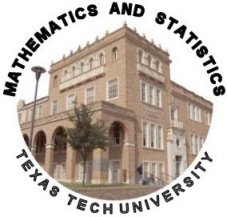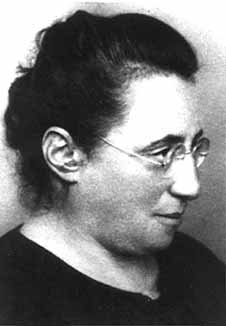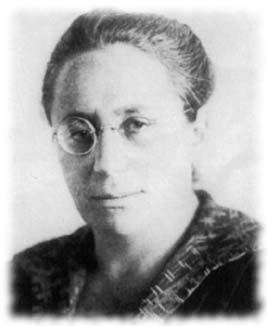
 |
3rd Emmy Noether High School Mathematics Day |
| Texas Tech University, Department of Mathematics and Statistics | |
| May 4th 2005 | |
|
workshops - Competition - Career Panel - Schedule
Location - Registration
Sponsors:
MAA Texas Tech Student Chapter Department of Mathematics and Statistics, TTU College of Arts and Sciences, TTU The Office of the Provost, TTU CLEAR and the Center for Engineering Outreach
|

|
|
Workshops for Students
|
 |
|
A Picture Contains Thousands of Numbers “A picture is worth a thousand words.” - Napoleon Bonaparte This famous quote is a reminder of the incredible impact a picture can have on our perception. Pictures have always had the ability to quickly tell us about a person, place, situation, or event but did you know that most pictures today are made from numbers? Thousands of them? These types of pictures are called digital images and they are everywhere! Every image on a computer, transmitted via the Internet, reproduced on a printer, and even taken by most modern cameras is a digital image defined by a large array, or grid, of numbers. Each number in a digital image represents the color or grayscale value of the image at the location of that number within the grid. And because digital images are made up of numbers, mathematics can be used to improve, analyze, and compress them. In this workshop, we will see examples of digital images and learn how they are described by numbers. We will look at how mathematics can be applied to the numbers of an image for purposes such as improving a blurry or noisy image, analyzing the content of an image, and reducing the amount of numbers necessary to describe an image.
|
|
|
Mathematical Modeling and Signal Processing in Wind Related Research Our society is increasingly exposed to atmospheric hazards such as hurricanes, tornadoes, and severe thunderstorms. Every year, these hazards cause many fatalities and injuries, major disruption in community lifelines such as power, communications, transportation, and significant property damage. Recent advances in mathematical modeling and signal processing techniques offer the promise of better understanding of these wind events. This workshop will focus on how signal processing techniques based on data analysis can be used to solve some wind related problems. Illustrations presented in the workshop will include the following applications: using three-dimensional Doppler radar data for tornado detection; modeling a hurricane storm track; studying the formations of the wind-induced vortices on a building; detecting localized structures during thunderstorm outflows.
|
|
|
Diophantine Equations In this talk we will discuss Diophantine equations, which are equations with two or more unknowns for which we search for integer solutions. We will examine first and (possibly) second degree Diophantine equations, and we will solve some applied problems where these equations appear.
|
|
|
The Curves of Love Since ancient times people have drawn hearts to convey a message of love. Few of them would ever imagine that such a picture would arise in a mathematical exercise: First draw a circle in the plane. Then imagine that another similar circle is moving along it. Let A denote the point on both circles where they meet at the beginning and trace its trajectory as the second circle moves. The trajectory will be a heart-shaped curve called a cardioid. Cardioids are interesting examples of curves whose mathematical expression is tedious if one uses the rectangular coordinate system but becomes fairly simple if instead one resorts to polar coordinates. In this workshop we will take a look at cardioids, polar coordinates and a seductive mathematical transformation that makes something tedious become neat.
|
|
|
|
|
|
Mathematics has no Answers Have you ever wondered where the word problems in your algebra book come from? In this workshop we will expose their source and try to decide if a selection of these problems are dumb, dumber or dumbest! We will take a close look at one problem in particular. We look at the problem “If Jane can mow the yard in 1 hour and her brother John can mow the yard in two hours how long will it take them to mow the lawn if they work together?” in some detail. We will find the origins of this problem in cave art from the Pleistocene. We will ask the eternal question “Does this problem make sense?” and find the answer that is surely NO. However, we will try to find a version of the problem that does make sense and in doing so we discover that mathematics doesn’t have answers but is only a tool for helping to make real life decisions.
|
|
|
THE ENTIRE WORLD COMPRESSED IN A DISK OR HYPERBOLIC GEOMETRY The hyperbolic plane is embedded inside of a disk; the edge of the disk represents infinity. In hyperbolic geometry, the sum of the angles of a triangle is always less than 180 degrees. An amazing fact here is that there is an upper limit to the possible area a triangle can have, even though there is no upper limit for the lengths of the sides of the triangle. We will interactively draw polygons in the hyperbolic plane, and prizes will be given for creating the most beautiful hyperbolic snowflakes!
|
|
|
Workshops for Teachers
|
|
|
What Does
Mathematics Have to Do with Infectious Diseases?
|
|
|
Mathematical games in k-12 classrooms A series of
mathematical games will be presented. These games will
|
| Competition |
 |
|
|
The problems are posed by Dr. Wayne Lewis (Department of Mathematics and Statistics, Texas Tech University). Awards are sponsored by the Texas Tech University local Student Chapter of the MAA and SIAM. |
||
|
Career Panel On Becoming a Mathematician |
 |
|
Dr. Delores Ludwig, Director of Cooperative Education (Office of the Dean of Engineering, Texas Tech University) leads the discussion.
|
|
|
Panelists:
|
|
|
Hi, my name is Rachel Cline and I am currently a math Ph.D. student at Tech. Let me tell you a little about myself. I graduated from Lake View High School in San Angelo, TX in 1998. I attend Angelo State University from 1998-2002 and received a Bachelor of Science in Mathematics. Afterward, I felt that I still had more math to learn so I went to grad school at Texas Tech University and received my Masters of Science in Mathematics in August 2004. Now I am currently pursuing a Ph.D. in Mathematics, because I still have more mathematics to learn. I really enjoy working with kids and teaching students of all ages math.
For the last year and a half, I’ve been teaching girls
math at O.L. Slaton Junior High Math Club for Girls. I’ve also been working
with IDEAL and have taught math for Science: It’s A Girl Thing and Super
Saturdays. This Spring Break, I went a little outside math and taught the
evidence collection class for Caprock: CSI (Crime Scene Investigation) for
junior high students.
|
|
|
Krista Gerlich is in her second year as an assistant coach for the Lady Raiders. Gerlich returns to Texas Tech after a stellar playing career for the Lady Raiders from 1989-93 and was the shooting guard on the 1993 National Championship team. Gerlich returns to the court after taking time off to start a family. Prior to her arrival at Tech, she was teaching math at Hereford High School for the 2002-03 year, where her husband, Bryan, was the athletic director and head football coach. After graduating from Tech in 1993 with a degree in Exercise and Sports Science, Gerlich got her first coaching job at Lockney High School where she was the head girls basketball coach. From 1994-97, she was the head girls coach at Taft High School in San Antonio, Texas. From there, Gerlich hit the college ranks as an assistant at the University of Texas at San Antonio from 1997-99. While at UTSA, she was the number one assistant and recruiting coordinator. Gerlich then was the head coach at San Antonio Reagan High School from 1999-2000. In the inaugural season at Reagan, the team posted a 20-5 mark. Before her stint at Hereford, Gerlich was a math teacher at Tahoka High School from 2000-2002. Her husband was the athletic director and head football coach at Tahoka. Gerlich also received her master's degree in Educational Administration in 1997 from Texas A&M-Kingsville. Gerlich and her husband, Bryan, who is also a Tech graduate and was a linebacker on the Red Raider football team from 1987-92, have a daughter, Bryn, and a son, Brayden.
|
|
|
I graduated from Texas Tech University with a BA in 1985 and an MS in 1988, both in mathematics. I've been teaching undergraduates at the university and community college levels for 19 years, and spent 7 summers teaching mathematics enrichment courses to middle school and high school. I'm currently an Assistant Professor at the University of Cincinnati.
|
|
|
My current title is Executive Program Analyst. I work for the Research and Evaluation Department of the San Antonio Independent School District. My two main responsibilities include Student Enrollment Projections and the Evaluation of the Bilingual and ESL Programs. I also assist in designing ways to improve data quality. After I received my Master’s Degree in Statistics from Texas Tech (1997) I worked in Dallas for 5 years as an Evaluation Specialist for the Department of Research and Evaluation of the Dallas Independent School District. In Dallas my responsibility was program evaluation. I evaluated a variety of programs such as Staff Development, Elementary Bilingual/ESL Programs, and Elementary reading Programs. I received my Bachelors of Arts in Mathematics with a minor in English from St. Mary’s University in San Antonio (1995). |
|
|
|
| Schedule | |
|
9:00-9:30 CHEM 049 |
Welcome and Introduction by Dr. Jane Winer, Dean of the College of Arts & Sciences, and our Department Head Dr. Lawrence Schovanec
Special Guest Speaker: Dr. Pamela Eibeck, Dean of the College of Engineering
|
|
9:30-10:45 CHEM 049 and CHEM 107
|
Student Competition: Problems posed by Dr. Wayne Lewis |
|
9:40-10:40 MATH110
|
Workshop I for Teachers Dr. Jerry Dwyer Mathematical games in k-12 classrooms |
|
11:00-11:50 MATH010
MATH011
MATH012
MATH013
MATH014
MATH015
|
Workshops I for Students Group 1:
Dr. Magdalena Toda:
Group 2: Dr. Kathleen Gilliam: Mathematical Modeling and Signal Processing in Wind Related Research
Group 3: Dr. Molly Dickens A Picture Contains Thousands of Numbers
Group 4: Dr. Lourdes Juan The Curves of Love
Group 5: Dr. Clyde Martin Mathematics has no Answers
Group 6: Dr. Petros Hadjicostas: Diophantine Equations |
|
12:00-1:00 Frazier Pavilion
|
lunch |
|
1:05-1:55 same classrooms as in the morning
|
Workshops II for Students
|
|
MATH108 |
Workshop II for Teachers Dr. Lih-Ing Roeger What Does Mathematics Have to Do with Infectious Diseases?
|
|
2:00-2:30 CHEM 049
|
Career Panel On Becoming a Mathematician led by Dr. Delores Ludwig, with Rachel Cline, Krista Gerlich, Denise Johansen, and Theresa Urrabazo
|
|
2:30 - 3:00 CHEM 049
|
Awards, Evaluations, and Closing |